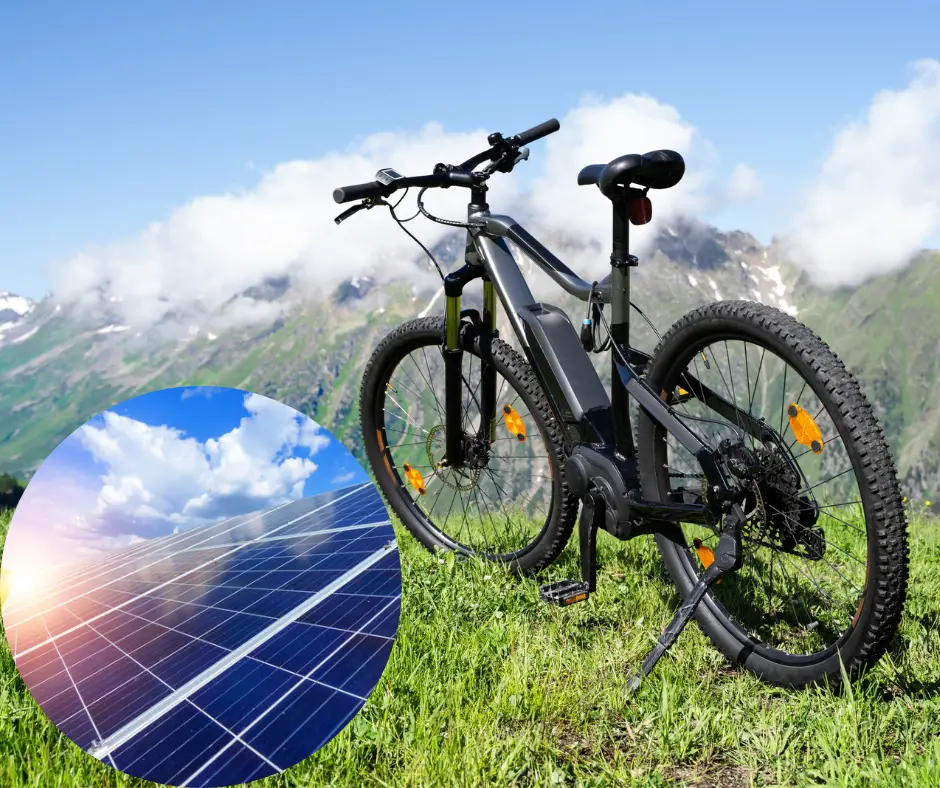Electric bikes, also known as e-bikes, are a sustainable and eco-friendly alternative to traditional gasoline-powered bicycles. They are powered by a rechargeable battery and an electric motor, which assist the rider in pedaling. This means that riders can travel further and faster with less physical exertion. Electric bikes have become increasingly popular in recent years as more people look for alternatives to cars for short commutes and leisure activities.
One of the most innovative and exciting developments in the world of electric bikes is the concept of using solar power to recharge them. Solar energy is a clean, renewable, and abundant source of energy that can be harnessed to power all kinds of devices, including electric bikes. By using solar panels to charge the batteries of electric bikes, riders can reduce their dependence on fossil fuels and lower their carbon footprint.

Using solar power to recharge electric bikes is not only good for the environment, but it can also save riders money in the long run. Unlike traditional gasoline-powered bicycles, solar-powered electric bikes do not require any fuel and have lower maintenance costs. Furthermore, the cost of solar panels has decreased significantly in recent years, making them more affordable and accessible to the general public. In this blog post, we will explore the concept of using solar power to recharge electric bikes in more detail and discuss the potential benefits and challenges of this technology.
Understanding the Mechanics of Electric Bikes
Electric bikes, also known as e-bikes, have become increasingly popular in recent years as a sustainable and efficient mode of transportation. But how exactly do these bikes work? In this section, we’ll take a closer look at the battery, motor, charging, and range of electric bikes to better understand their mechanics.
- The Battery: Electric bikes are powered by a rechargeable battery, typically a lithium-ion battery. These batteries are lightweight and have a long lifespan, making them an ideal choice for e-bikes. The capacity of the battery is measured in watt-hours (Wh), and the larger the capacity, the further the bike can travel on a single charge.
- The Motor: The electric motor is responsible for providing the power to the bike. It’s typically located in the hub of the front or rear wheel, but can also be found in the middle of the bike frame. The motor is controlled by a sensor that detects when the rider is pedaling and adjusts the level of assistance accordingly.
- Charging: Electric bike batteries can be charged using a regular household outlet. The charging time varies depending on the battery capacity and the charging unit, but it typically takes between 2-4 hours to fully charge a battery. Some e-bikes also have the option to charge the battery while pedaling, known as regenerative braking.
- Range and Speed: The range of an electric bike is determined by the battery capacity and the level of assistance provided by the motor. On average, an electric bike can travel between 20-50 miles on a single charge, but this can vary depending on the specific bike and the rider’s weight, terrain, and riding style. Electric bikes can also reach speeds of up to 20-28 mph, depending on local regulations.
However, electric bikes are a practical and environmentally-friendly mode of transportation that are powered by a rechargeable battery and electric motor. Understanding the mechanics of these bikes, such as the battery, motor, charging, and range, can help riders make informed decisions when purchasing or using an electric bike.
Harnessing the Power of the Sun: Solar Panels for Electric Bike Charging
Electric bikes are a great way to reduce our carbon footprint, but the traditional method of charging the batteries can still be a source of pollution. However, by using solar power to charge electric bikes, we can significantly reduce our environmental impact. In this section, we will explore the advantages of using solar power, the types of solar panels available for electric bikes, and the installation and maintenance of these panels.
Advantages of using solar power:
- Solar power is a clean and renewable energy source. It does not produce any emissions and does not deplete natural resources.
- Solar panels can be installed on the electric bike itself, meaning that you can charge your bike while you ride.
- Using solar power can save you money on electricity bills in the long run.
Types of solar panels available for electric bikes:
- Flexible solar panels: These are lightweight and can be easily mounted on the frame of the bike. They are also durable and can withstand the wear and tear of daily use.
- Portable solar panels: These are small and can be easily carried with you, making them great for long trips.
- Integrated solar panels: These are built into the bike itself, making them a seamless addition to the design.
Installation and maintenance of solar panels:
- Installing solar panels on an electric bike is a relatively simple process that can be done by most people with some basic DIY skills.
- Maintenance of the solar panels is minimal, as they do not have any moving parts and are not affected by weather. Regular cleaning and checking for damage is all that is required.
Overall, solar panels are an excellent way to power electric bikes and can provide many benefits. By harnessing the power of the sun, we can reduce our environmental impact and save money in the long run. With the variety of solar panels available and their easy installation and maintenance, solar power is a great option for electric bike owners.
Can an Electric Bike Recharge While Riding?
Electric bikes have been gaining popularity as a sustainable mode of transportation. One of the most frequently asked questions about electric bikes is whether they can recharge while riding. This is an important question as it has the potential to greatly increase the range of electric bikes and make them even more practical for daily use. In this section, we will explore the feasibility of recharging electric bikes while riding, potential challenges and limitations, and current technology and future possibilities.
The Feasibility of Recharging While Riding
The idea of recharging an electric bike while riding is not new. The concept is to use the energy generated by the rider’s pedaling or the bike’s kinetic energy to recharge the battery. This can be achieved through the use of special generators or through the use of regenerative braking systems. However, the feasibility of recharging while riding is still a topic of debate.
One of the main arguments against recharging while riding is that the energy generated by pedaling or braking is not enough to significantly recharge the battery. Additionally, the weight and complexity of the necessary equipment could make the bike less efficient and more difficult to ride.
Potential Challenges and Limitations
Despite the potential benefits, there are several challenges and limitations to recharging electric bikes while riding. One of the main challenges is the lack of standardization in the technology. Currently, there are several different systems and devices available, each with their own unique benefits and drawbacks. Additionally, there is a lack of standardization in the battery systems used in electric bikes, which can make it difficult to integrate recharging while riding technology.
Another challenge is the cost. While recharging while riding technology is still in its infancy, the cost of the necessary equipment can be prohibitively expensive for many riders. Additionally, the added weight and complexity of the equipment can make the bike less efficient and more difficult to ride.
Current Technology and Future Possibilities
Currently, there are several different systems and devices available for recharging electric bikes while riding. These include special generators, regenerative braking systems, and even hybrid systems that combine both. However, most of these systems are still in the prototype or testing phase, and it may be some time before they are widely available to the public.
Despite the challenges and limitations, the future of recharging electric bikes while riding is promising. With continued research and development, it is likely that more efficient and cost-effective systems will be developed. Additionally, as electric bikes continue to gain popularity, there will be more demand for recharging while riding technology, which will drive innovation in this field.
However, recharging electric bikes while riding is a topic of ongoing debate. The idea is to use the energy generated by the rider’s pedaling or the bike’s kinetic energy to recharge the battery. However, there are several challenges and limitations to recharging while riding, including the lack of standardization in the technology, the cost, and the added weight and complexity of the equipment. Despite these challenges, the future of recharging electric bikes while riding is promising as new technology is developed.
FAQs
Can electric bikes be charged by solar?
Yes, electric bikes can be charged by solar power. This can be done by using a solar panel to charge the bike’s battery, or by installing a hybrid system that combines pedaling and solar power to charge the battery.
Can you charge an e-bike while riding?
The idea of recharging an e-bike while riding is not new. The concept is to use the energy generated by the rider’s pedaling or the bike’s kinetic energy to recharge the battery. This can be achieved through the use of special generators or through the use of regenerative braking systems. However, the feasibility of recharging while riding is still a topic of debate and is not a common feature in e-bikes currently on the market.
How long does it take to charge an e-bike with solar?
The time it takes to charge an e-bike with solar power depends on several factors, including the size of the solar panel, the capacity of the battery, and the amount of sunlight available. On average, it takes about 4-6 hours to fully charge an e-bike battery using a solar panel.
Can you charge a motorcycle battery with solar?
Yes, it is possible to charge a motorcycle battery with solar power. This can be done by using a solar panel to charge the battery, or by installing a hybrid system that combines pedaling and solar power to charge the battery.
